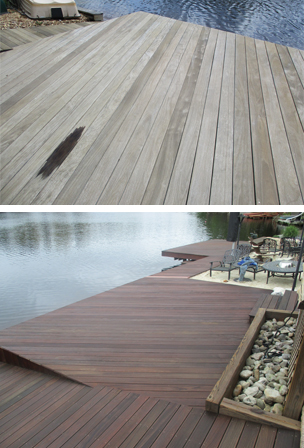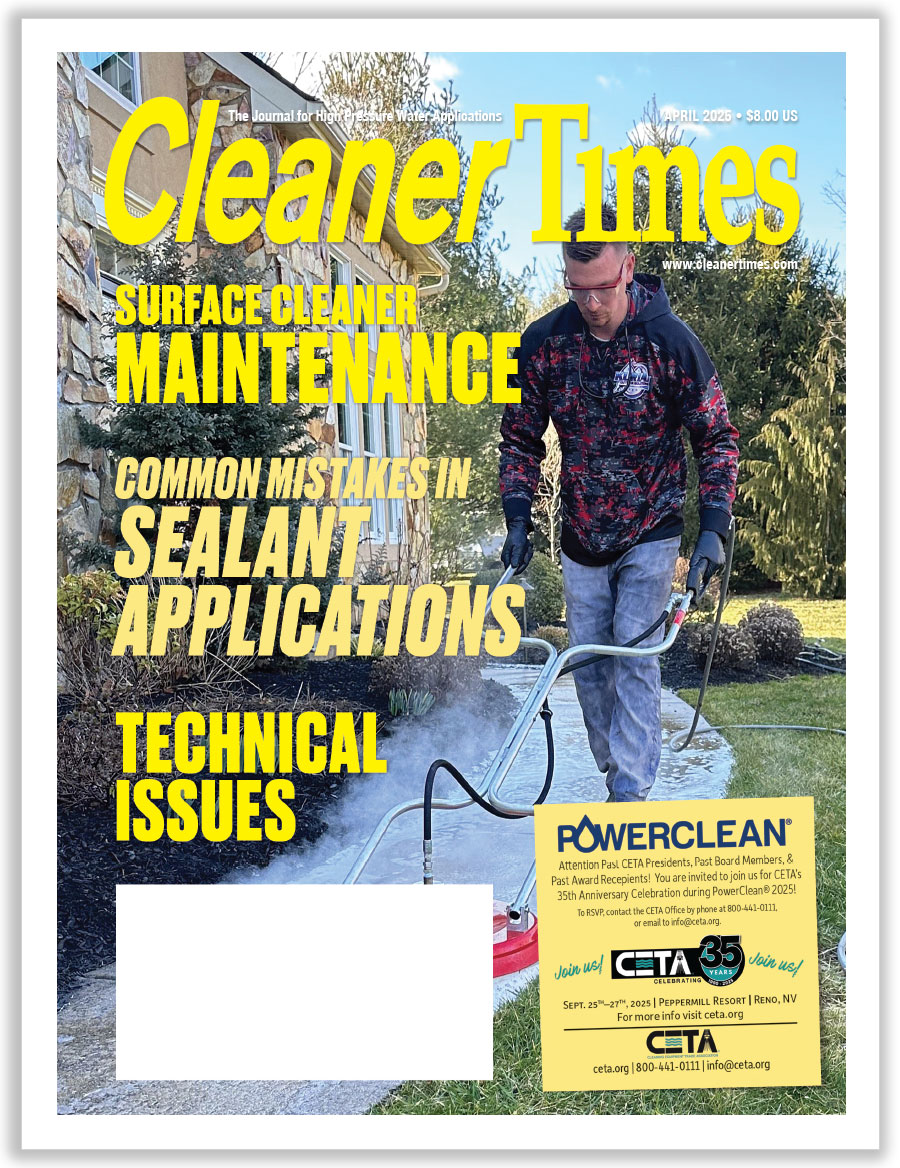
Cleaning and Sealing Surfaces
By Diane M. Calabrese / Published July 2022

Apply an impermeable coating to a porous surface. That’s the simplest definition of what “to seal” means. A definition does not answer the basic questions, though, such as which surfaces should be sealed, how often, and best methods for cleaning prior to sealing. Each type of surface comes with many variables.
Fortunately, in 2022 manufacturers give explicit instructions on how best to clean and, if appropriate, seal their products. Always use that advice when it’s available.
Which are the essential elements of sealing? We turn to Clint Reynolds, a Deco Products Inc. expert, for a list. (Reynold’s company is headquartered in Denver, CO.)
“Sealing is typically defined as blocking water transmission,” says Reynolds. With that, it must be part of a process that begins with cleaning.
“Any sealer you use is only as good as the cleaning process,” says Reynolds. “If you leave dirt, grime, or any other foreign object on the substrate, it will impair the sealer from performing as needed.”
There are some “should” and “should not” surfaces in the context of sealing. “All porous surfaces,
pavers, barrel roof tile, and concrete surfaces should be sealed, especially those exposed to the weather, to protect them from degradation,” says Reynolds.
And surfaces that should not be sealed? “Porcelain or glazed surfaces should not be sealed, especially with penetrator sealers,” says Reynolds. “Sealers will not stick to or penetrate these materials.”
If water penetrates a surface, it’s capable of doing damage all on its own through changes in state. Freezing and then thawing is a bane to concrete, the most vulnerable types of which crumble in response.
But the universal solvent can carry plenty of trouble with it into pores. Salt dissolved in water is the most apparent, but spores from fungi and other organisms can easily hitch a ride.
Sealing extends the serviceable life of a surface. So, the protection that can be seen in newly sealed surfaces—water beading up—is reassuring.
The process of sealing, however, entails many layers of awareness. For one, a contractor may often
be working with VOCs [volatile organic compounds], which means adherence to all regulations for their use. (Consider precautions to protect both workers and environment as part of the process.)
Another issue is how to communicate to customers to persuade them that sealing makes sense. Customers may look at the additional cost and the increased longevity of the surface and conclude, “I won’t be here that long,” or, “I like a weathered look.”
Given there are plenty of customers who have never taken the time to observe the waste that weather lays to unsealed surfaces, a contractor must be prepared to show as well as tell. Photos of what happens to unsealed surfaces can substitute for the firsthand experience many prospective customers lack.
Cleaning Made Easier
One tack to take when persuading a customer to invest in sealing is to point out that sealing will make subsequent cleaning easier (and generally faster—i.e., less time on property). It’s an important economic outcome, but it also has an environmental component: less cleaning, less water and chemical used, and better for the environment.
“Sealing can serve two main purposes: one to protect and extend the life of what is being sealed and the other to help us to ‘future maintenance clean,’” says Everett Abrams, owner of Deck Restoration Plus/DRP Enterprises in Shamong, NJ. “We use sealers on cars, fleets, homes, and more to put a coating on a surface so that when organic dirt and grime attach to a surface, they are on top of the sealer.”
A sealed surface makes life easier in many ways for the contractor and for the property owner. “Sealing makes it easier to clean and is in common use for maintenance cleaning of any surface,” Abrams says.
Indeed, the value derived from sealing becomes even more apparent in economic terms when costs of material, labor, and energy are climbing everywhere. “Sealing to protect a surface and extend the life of it is a selling feature to a customer because with rapidly rising costs, extending the life of a structure or surface saves money in the long run,” explains Abrams.
Yes, sealing can give a real boost to longevity. Pause, though, to make certain the surface ought to be sealed.
“With all the good sealing does, keep in mind it is a case-by-case basis…,” says Abrams. “For instance, with wood, softwoods should be sealed no matter what. In the case of some hardwoods, they can be left to patina for years; then when you decide to clean or restore, it comes back to beautiful, and the wood will still have a much longer lifespan than softwoods.”
Then, there’s masonry. “Masonry surfaces do not need to be sealed, but for appearance reasons and maintenance cleaning purposes, they are,” says Abrams.
“I would say wood is the one surface we should always seal because it truly extends the life of the structure,” explains Abrams. “For instance, a typical deck left unsealed will fail in seven to 12 years due to cracking, rotting, warping, and bowing. A typical deck maintained will last 20 years plus.”
Cleaning is a critical part of any sealing project, and wood provides a good example. “The success of a coating is all in the prep of the project,” says Abrams. “This relates to the cleaning process, where we are trying to eradicate the organic growth before applying a coating.”
It can “cause a multitude of issues” when the “wood surface is not correctly cleaned and prepped,” says Abrams. “Wood is a porous surface, and organic growth can actually root ‘in’ the wood.”
Should there be such growth going on in the wood, it must be extricated—by proper cleaning—prior to application of seal. Otherwise, within a few months, the growth can continue under the seal, explains Abrams. A sign would be the wood turning “very black under the coating where the growth is rapidly growing.”
 How would such a problem—growth under seal—be resolved? “This means fully stripping the coating recently applied, a coating not meant to come off so soon,” says Abrams.
How would such a problem—growth under seal—be resolved? “This means fully stripping the coating recently applied, a coating not meant to come off so soon,” says Abrams.
In addition to the technical issues, contractors must be versed in the aesthetic concerns of customers. “Different types of sealer will have different characteristics like sheen and longevity that should be weighed before starting a project,” says Abrams.
Again, contractors who can show—often, not just with photos, but with actual pieces of wood or other substrate—better capture the attention of prospective clients.
From his vantage, Abrams has developed a definition of sealing that he believes serves well: “Sealing defined by me would be to apply a protective coating to aid in the maintenance of a surface, structure, or asset. The sealer could actually be wax, as in the case of our vehicles, [or it could be a coating of] oil or other product that protects any surface.”
Masonry Matters
A standout among the many excellent guides to cleaning and sealing is a Technical Preservation Services brief from the National Park Service of the U.S. Department of Interior: “Assessing Cleaning and Water-Repellent Treatments for Historic Masonry Buildings.”
The NPS handles preservation of historic buildings in parks, and many of the buildings are masonry structures. Contractors in certain parts of the nation do not encounter much masonry, but the guidance applies at any scale.
Contractors for residential and commercial customers share an overarching goal with NPS: Do no harm.
To avoid trouble, the NPS brief recommends that time be taken to positively identify what is to be removed in cleaning. Is it soot from smoke, or is it a metallic stain? The method for removal can be much gentler with the former. Similarly, is it genuinely biological growth, or is it some floral debris left on the surface by tendrils? Go gently on the tendrils.
Moreover, the NPS brief recommends careful consideration of whether cleaning or removing paint from masonry is warranted. Crusts of gypsum and sulfate can become so integral to the stone that they
cannot be removed without removing some of the masonry.
The 12-page brief from NPS reviews methods for cleaning and offers useful perspectives and tips. NPS encourages us to make a distinction between water-repellent coatings and waterproof coatings. Water-repellent coatings (usually transparent) do not seal, given they allow water to exit, while impeding the movement of water into the masonry.
Waterproof coatings do seal. That is, they keep water vapor and water from penetrating. Bituminous coatings (like those used on highway pavement) and elastomeric coatings fall into this category.
The NPS is not particularly an advocate of sealing masonry—with a few exceptions. Soft brick (brick from the 18th and early 19th centuries that was not completely fired) may benefit. Graffiti barriers may act secondarily as sealants, but they are primarily intended to simplify removal of graffiti.
When available, advice from the manufacturer of a surface product about how to clean and seal is the best; follow it. That’s what the NPS brief says and we recommend.






